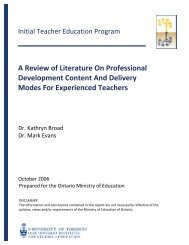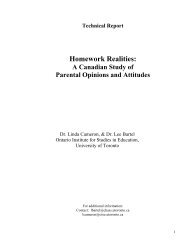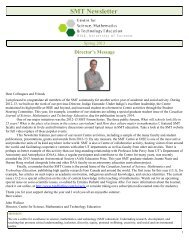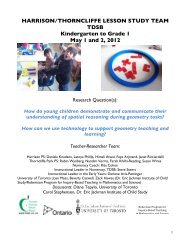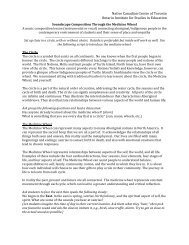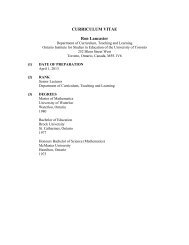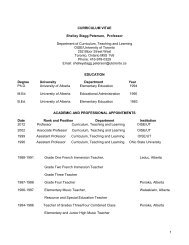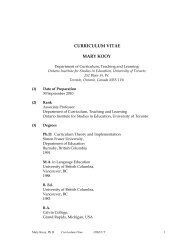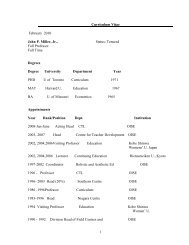The Ontario Curriculum, Grades 9-12 - Ministère de l'éducation ...
The Ontario Curriculum, Grades 9-12 - Ministère de l'éducation ...
The Ontario Curriculum, Grades 9-12 - Ministère de l'éducation ...
You also want an ePaper? Increase the reach of your titles
YUMPU automatically turns print PDFs into web optimized ePapers that Google loves.
B1.2 utilize a management plan for a specific application related to the green industries (e.g.,<br />
forest management plan, nutrient management plan, site layout plan, crop rotation plan,<br />
annual work plan, business plan, five-year operational plan)<br />
B1.3 <strong>de</strong>monstrate an un<strong>de</strong>rstanding of and apply techniques related to the propagation and<br />
maintenance of a variety of plant and/or animal species and the post-harvest handling of<br />
plant products (e.g., techniques related to crop, mammal, and poultry production, sexual<br />
and asexual plant production, shrub rejuvenation, rose processing, care of selected local<br />
tree species)<br />
B1.4 <strong>de</strong>monstrate an un<strong>de</strong>rstanding of and apply techniques or processes that promote<br />
biodiversity, increase ecosystem function, and reduce maintenance requirements (e.g.,<br />
planting native species, mulching, establishing natural habitat)<br />
B2. Plant and Animal Management Strategies<br />
B2. apply management strategies for assessing and controlling biotic and abiotic factors that<br />
affect plant and/or animal quality<br />
B2.1 apply a variety of methods to monitor and assess biotic factors that affect plant and/or<br />
animal quality (e.g., weed i<strong>de</strong>ntification, regular animal health inspections, plant quality<br />
inspections, pest scouting, post-harvest tracking of product freshness and quality)<br />
B2.2 apply a variety of methods to monitor and assess abiotic factors that affect plant and/or<br />
animal quality (e.g., nutrient balance analysis, soil testing, plant tissue analysis,<br />
monitoring growing <strong>de</strong>gree days [GDDs], form <strong>de</strong>fect analysis, water testing)<br />
B2.3 apply a variety of techniques to control pests and reduce plant and/or animal <strong>de</strong>fects (e.g.,<br />
maintenance or enhancement of natural barriers to control pest migration, animal<br />
quarantine, log hydration, integrated pest management)<br />
C. Technology, the Environment, and Society<br />
C1. Technology and the Environment<br />
C1. analyse the impact of the green industries on the environment and <strong>de</strong>scribe ways of<br />
minimizing harmful effects<br />
C1.1 <strong>de</strong>monstrate an un<strong>de</strong>rstanding of ecological relationships and processes (e.g., food webs,<br />
symbiotic relationships, ecological succession, nutrient flows and cycles, habitat and<br />
species diversity) that can affect or be affected by green industry operations<br />
C1.2 analyse the effects of green industry activities on the environment in the past and in the<br />
present (e.g., logging practices, irrigation, fertilization, pest control, nutrient and<br />
waste management)<br />
C1.3 assess the advantages and disadvantages of using natural rather than manufactured materials<br />
or products in green industry activities (e.g., natural fertilizers and pest control methods<br />
rather than chemical fertilizers and pestici<strong>de</strong>s, real flowers rather than artificial flowers,<br />
real grass rather than artificial turf, untreated rather than pressure-treated lumber)<br />
C1.4 i<strong>de</strong>ntify sustainable practices and gui<strong>de</strong>lines that are currently applied within the green<br />
industries or may be applied in the future (e.g., environmental farm planning, integrated<br />
pest management, xeriscaping, forest regeneration, low-till cultivation)<br />
C1.5 explain the environmental implications (e.g., effects on landfill lifespan and water and air<br />
quality) of using particular materials, products, processes, and disposal methods (e.g.,<br />
186 Environmental Education, <strong>Gra<strong>de</strong>s</strong> 9−<strong>12</strong>: Scope and Sequence of Expectations, 2011



